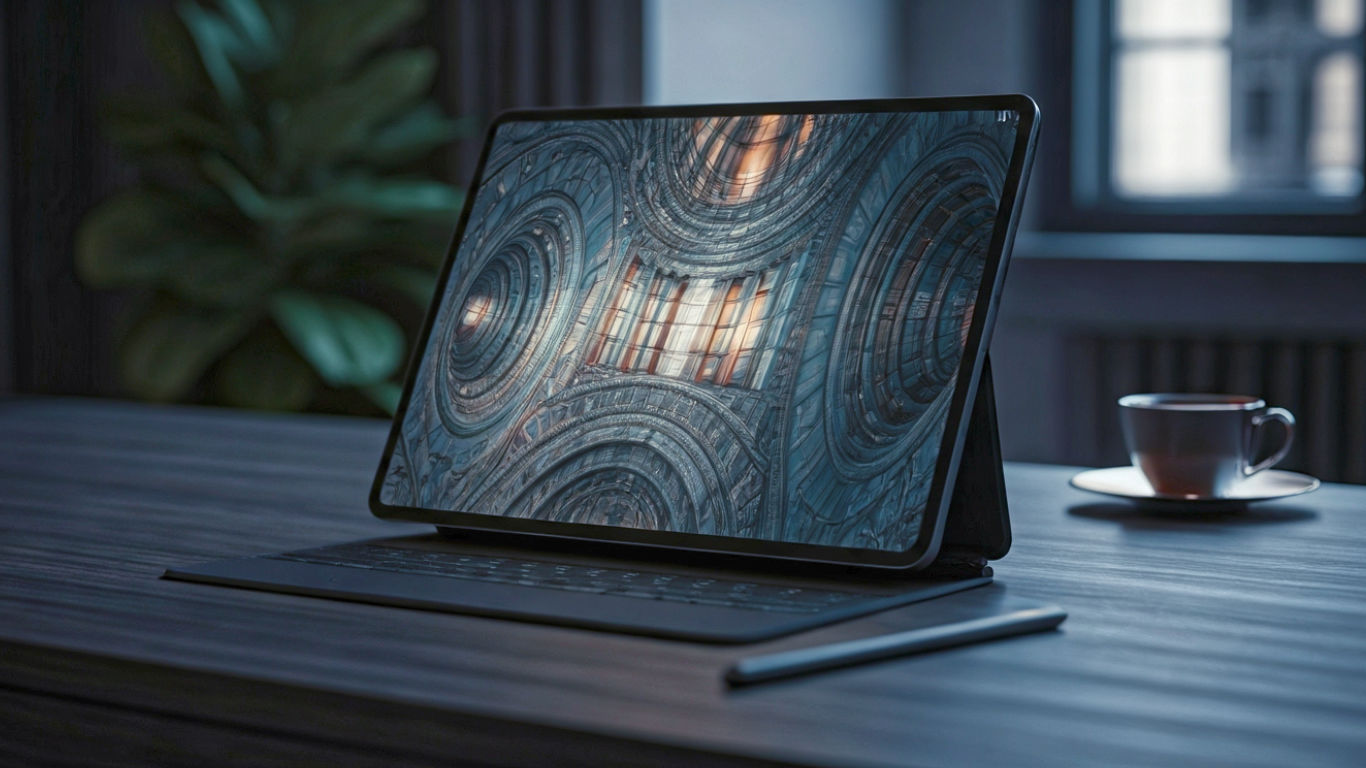iPad Pro M4 Review: Is This the Ultimate Upgrade?
Is the ridiculously thin and powerful new iPad Pro 13-inch worth the high price? Our definitive UK review breaks down everything you need to know.

This post may contain affiliate links. If you make a purchase through these links, we may earn a commission at no additional cost to you.
For years, the iPad Pro has been sitting at the top of the tablet food chain, a bit like a lion surveying its kingdom. It’s always been powerful, beautiful, and expensive. But with the M4 model, Apple seems to have decided that being the king isn’t enough. Now, it wants to be a god. This isn’t just another yearly update; it’s a complete rethink of what an iPad can be. It’s thinner than any device Apple has ever made, packs a brand-new M4 chip that laughs in the face of demanding tasks, and has a screen so advanced they had to invent a new name for it.
But let’s be honest. For most of us here in the UK, an iPad is for browsing the web on the sofa, watching iPlayer in bed, or keeping the kids quiet on a long car journey to Cornwall. Does anyone really need a device this powerful? Apple is betting that they can convince you that you do. They’re aiming this squarely at the professionals – the artists, the designers, the video editors – but also at those of us who just want the absolute best bit of kit money can buy.
So, is this new iPad Pro the future of computing, a beautiful but unnecessary luxury, or something in between? We’re going to dive deep into every aspect of this device, from its impossibly thin design to the raw power of the M4 chip. We’ll look at the jaw-dropping new display, see if the new Apple Pencil Pro and Magic Keyboard are worth the extra cash, and figure out if the battery can actually last a full day of British weather-induced indoor activity. Grab a cup of tea, and let’s find out if the 2024 iPad Pro is truly worth your hard-earned pounds.
Unboxing and First Impressions: Thinner Than a Pencil
Holding the new iPad Pro for the first time is a genuinely weird experience. At just 5.1mm thick, it feels less like a powerful computer and more like a fragile sheet of glass and aluminium. It’s thinner than the Apple Pencil you use with it, thinner than most smartphones, and frankly, a bit unnerving. You’ll immediately start wondering if it’s going to snap in half. Apple, of course, insists it’s incredibly strong, thanks to some clever internal engineering. But that initial feeling of fragility is hard to shake.
Apple iPad Pro 13-inch (M4)
-
Features a 13-inch Ultra Retina XDR display with extreme brightness, contrast, and exceptional color accuracy, plus advanced technologies like ProMotion and True Tone.
-
Built for Apple Intelligence, a personal intelligence system that helps you write, express yourself, and get things done with groundbreaking privacy protections.
-
The M4 chip delivers powerful performance with up to a 10-core CPU and a 10-core GPU, supported by all-day battery life.
-
Offers up to 2TB of storage, allowing you to store everything from apps to large files like 4K video.
-
Runs on iPadOS, which enables multitasking with features like Stage Manager, and comes with essential apps, with over a million more on the App Store.
-
Compatible with Apple Pencil Pro and Magic Keyboard (sold separately) for an enhanced drawing, note-taking, and typing experience.
-
Equipped with advanced cameras, including a landscape 12MP Ultra Wide front camera with Centre Stage and a 12MP Wide back camera that supports 4K ProRes video.
-
Includes Wi-Fi 6E for fast wireless connections and a USB-C connector with Thunderbolt / USB 4 support for connecting to external displays and drives.
-
Uses Face ID for secure unlocking, authenticating purchases, and signing into apps.
The Design: A Familiar Face, Slimmed Down
Aesthetically, it’s still very much an iPad. You’ve got the flat edges, the rounded corners, and the minimalist aluminium back. The two colour options, Silver and a new Space Black, are both smart and understated. The Space Black, in particular, does a great job of hiding fingerprints, which is a welcome change from previous dark-coloured iPads that were smudge magnets.
The biggest physical change, apart from the thinness, is the new position of the front-facing camera. It’s finally been moved to the landscape (long) edge. This is a small change that makes a huge difference. For years, video calls on the iPad have been a bit awkward, with you looking off to the side. Now, when you’re on a Zoom call with it docked in a keyboard, you’re looking directly at the camera. It’s how it should have been all along.
What’s in the Box? (And What’s Not)
The unboxing experience is typical Apple: clean, simple, and satisfying. You lift the lid to reveal the iPad Pro itself. Underneath, you’ll find a 1-metre USB-C charging cable and some paperwork. And that’s it.
Yes, you read that right. There is no power adapter in the box. Apple’s reasoning is that most people already have a drawer full of USB-C chargers, and leaving it out is better for the environment. While that might be true, it still feels a bit stingy when you’ve just spent over £1,200. If you don’t have a 20W USB-C plug, you’ll need to buy one separately. It’s a classic Apple move, and one that continues to annoy customers.
The Screen: A Quantum Leap in Display Technology
Let’s talk about the star of the show: the screen. Apple is calling it the Ultra Retina XDR display, which is a very fancy way of saying it’s the best screen they have ever put on any device. And honestly, they’re not wrong.
Tandem OLED: What Is It and Why Does It Matter?
For the first time ever, the iPad Pro uses OLED technology. Unlike traditional LCD screens that use a backlight to illuminate all the pixels, each pixel in an OLED screen creates its own light. This means you get perfect, inky blacks because the pixels can just turn off completely. The contrast is astonishing.
But Apple didn’t just use a standard OLED panel. They created something they call Tandem OLED. This means they’ve essentially stacked two OLED panels on top of each other. Why? To make it brighter. One of the traditional weaknesses of OLED has been its peak brightness, especially when showing a lot of white on screen. By combining the light from two panels, the new iPad Pro can reach a blinding 1000 nits of full-screen brightness and a peak of 1600 nits for HDR content (like high-end movies and TV shows).
The result is simply stunning. Colours are incredibly vibrant and accurate, blacks are truly black, and everything just pops off the screen. Watching a film like ‘Blade Runner 2049’ on this is a revelation. The bright neon signs of a futuristic city glow against the deep black of the night sky in a way that no LCD screen could ever manage.
ProMotion and True Tone: Smooth and Easy on the Eyes
The display also keeps the brilliant ProMotion technology, which allows the refresh rate to automatically adjust from as low as 10Hz to a super-smooth 120Hz. This means scrolling through websites or sketching with the Apple Pencil feels incredibly fluid and responsive. But when you’re looking at a static image, it drops the refresh rate to save battery. It’s the best of both worlds.
True Tone technology is here too, adjusting the white balance of the screen to match the ambient light in your room. This makes reading articles or ebooks much more comfortable and natural, almost like looking at a piece of paper.
Nano-Texture Glass: For the Professionals (At a Price)
If you opt for the 1TB or 2TB models, you have the option of choosing nano-texture glass. This is a special matte finish that’s etched into the glass at a microscopic level to reduce glare. For artists or video editors working in brightly lit studios, this could be a game-changer, providing a much clearer view of their work without distracting reflections. However, it comes at a significant extra cost and might slightly reduce the perceived contrast of the screen. For most people, the standard glossy screen will be more than good enough.
The M4 Chip: Outrageous Power in a Wafer-Thin Package
At the heart of the new iPad Pro is the brand-new Apple M4 chip. This is a big deal. For the first time, Apple has debuted a new generation of its silicon in an iPad rather than a Mac. It’s a clear statement that they see the iPad Pro as a proper computer, not just a companion device.
Performance: Faster Than You Can Say ‘Blimey’
So, what does the M4 actually do? In simple terms, it makes this iPad Pro ridiculously fast. The Central Processing Unit (CPU) is up to 50% faster than the M2 chip in the previous iPad Pro. The Graphics Processing Unit (GPU) is up to four times faster.
What does this mean in the real world? Apps open instantly. Multitasking with several demanding apps at once is effortless. Editing multiple streams of 4K video in Final Cut Pro or sculpting a complex 3D model in ZBrush feels as smooth as it would on a high-end laptop. For professional users, this power is a massive leap forward.
But what about for the rest of us? Honestly, it’s overkill. The M2 chip was already more powerful than most people would ever need. The M4 is on another level entirely. It’s like putting a Formula 1 engine in a Ford Focus. It’s incredibly impressive, but you’ll rarely get to use its full potential browsing Facebook or sending emails. The main benefit for the average user is future-proofing. This iPad is so powerful that it will still feel fast and responsive in five or six years’ time.
The Neural Engine and the Dawn of Apple Intelligence
A huge part of the M4 chip is its new Neural Engine, which Apple says is its most powerful ever. This part of the chip is specifically designed for Artificial Intelligence (AI) and machine learning tasks. It can perform a staggering 38 trillion operations per second.
This is the hardware that will power Apple Intelligence, the company’s new suite of AI features. This will allow you to do things like summarise long emails, create images from text descriptions, and get help writing documents, all on the device itself without sending your data to the cloud. The M4 chip is built to handle these tasks effortlessly, making the iPad Pro a seriously smart device.
Apple Pencil Pro and Magic Keyboard: The Essential (and Expensive) Extras
An iPad Pro is really only half a device without its accessories. The new Apple Pencil Pro and redesigned Magic Keyboard are designed to turn this tablet into a true productivity and creativity powerhouse. The only problem? They’re sold separately and they are not cheap.
Apple Pencil Pro: More Than Just a Stylus
The Apple Pencil has always been the best stylus for artists and note-takers. The new Pencil Pro adds some clever new tricks that make it even better.
- Squeeze Gesture: You can now squeeze the barrel of the Pencil to bring up a new tool palette, letting you quickly switch brushes, colours, or line weights without touching the screen. It’s customisable and feels surprisingly natural.
- Barrel Roll: A new gyroscope inside the Pencil lets it detect when you rotate it. This is brilliant for artists, as it allows you to change the orientation of a shaped brush, just like you would with a real calligraphy pen or paintbrush.
- Haptic Feedback: The Pencil Pro now has a small motor inside that provides a little tap of feedback when you use the squeeze gesture or snap an object into place. It’s a subtle but satisfying addition.
- Find My Integration: Thank goodness! You can now track your Apple Pencil Pro in the Find My app, just like your iPhone or AirPods. For anyone who has ever spent a frantic 10 minutes searching for their £129 stylus down the side of the sofa, this is a lifesaver.
For digital artists, illustrators, and designers, the new features of the Apple Pencil Pro are a significant upgrade, making the creative process feel more intuitive and tactile.
Magic Keyboard: Thinner, Lighter, and More Like a Laptop
The original Magic Keyboard was a brilliant piece of engineering, but it was also heavy and thick, turning the sleek iPad Pro into a bit of a brick. The new version has been completely redesigned to match the new iPad.
It’s noticeably thinner and lighter, making the whole package much more portable. It now has a full function row of keys, just like a MacBook keyboard, giving you quick access to controls for brightness, volume, and media playback. This was a major omission on the old model.
The trackpad is larger and now has haptic feedback, which makes clicks feel more satisfying. The keyboard itself still offers a great typing experience, with comfortable, backlit keys. The whole thing is wrapped in a durable aluminium shell that makes it feel much more premium.
The catch? It costs an eye-watering £349. That’s more than the price of a basic iPad. It’s an incredible accessory, but its price puts it firmly in the ‘professional tool’ category.
Cameras and Audio: Ready for Your Close-Up
The camera system on the iPad Pro has seen a few changes, some good, some… interesting.
The Front Camera: Finally in the Right Place
As mentioned earlier, the 12MP Ultra Wide front camera is now on the landscape edge. It supports Centre Stage, which uses machine learning to automatically pan and zoom to keep you in the frame during video calls. It’s a fantastic feature that works seamlessly, making video conferencing feel much more dynamic. For the millions of us now working from home, this is a truly meaningful upgrade.
The Back Cameras: Addition by Subtraction?
On the back, things are a little different. The previous iPad Pro had two cameras: a Wide and an Ultra Wide. The new model has just one: a 12MP Wide camera. Apple says that data showed very few people were using the Ultra Wide camera on their iPad, so they removed it.
The remaining camera is still excellent. It shoots sharp photos and records crisp 4K video, with support for the professional ProRes format. There’s also a new adaptive True Tone flash that uses AI to remove shadows when you’re scanning documents, stitching multiple photos together for a perfectly even image. It’s a clever feature that makes the iPad an even better document scanner.
You also still get the LiDAR scanner, which measures depth and is used for enhanced Augmented Reality (AR) experiences and for creating 3D models of spaces.
Audio: Four Speakers of Fury
The iPad Pro has a four-speaker audio system that delivers surprisingly rich and immersive sound. It’s loud, clear, and has a decent amount of bass for such a thin device. Watching movies or listening to music is a genuinely enjoyable experience. There are also four studio-quality microphones that capture clear audio for video calls and voice recordings.
Battery Life and Connectivity: All-Day Power
Despite its incredibly thin design and more powerful chip, Apple claims the new iPad Pro has the same “all-day” battery life as its predecessor. This translates to around 10 hours of web browsing or video watching over Wi-Fi.
In real-world testing, this claim holds up. With mixed usage – browsing, emails, watching some YouTube, and a bit of light photo editing – you can comfortably get through a full day without reaching for the charger. However, if you’re doing intensive tasks like editing 4K video or playing high-end games, that number will drop significantly. For a professional on the go, it’s enough to get you through a workday, but you’ll probably want to have your charger handy just in case.
Connectivity: Fast and Furious
The iPad Pro comes with Wi-Fi 6E, the latest and fastest standard, ensuring rapid downloads and smooth streaming. The USB-C port has also been upgraded to support Thunderbolt / USB 4, which offers incredibly fast data transfer speeds of up to 40Gbps. This is a huge deal for creative professionals who need to transfer large files, like video projects or high-resolution photo libraries, from external drives. It also allows you to connect to a high-resolution external display, like Apple’s Pro Display XDR, at full 6K resolution.
For those who need to stay connected on the move, there are Wi-Fi + Cellular models available, which support 5G for super-fast internet access when you’re away from a Wi-Fi network.
iPadOS: The Elephant in the Room
For all its incredible hardware, the iPad Pro is still limited by its software: iPadOS. While iPadOS has become much more capable over the years, with features like Stage Manager for better multitasking and support for external displays, it still isn’t as flexible as a traditional desktop operating system like macOS or Windows.
Stage Manager lets you have overlapping, resizable windows, but it can still feel a bit clunky and confusing compared to a Mac. You’re also limited to the apps available on the App Store. While there are fantastic, powerful apps like Final Cut Pro, Logic Pro, and the full Adobe suite, you can’t just install any piece of software you want.
For many professionals, iPadOS is powerful enough to be their main computer. An illustrator using Procreate or a photographer editing in Lightroom will feel right at home. But for others, like a programmer who needs a specific development environment or an office worker who relies on complex Excel macros, the limitations of iPadOS might still be a deal-breaker. The hardware is writing cheques that the software, in some cases, still can’t quite cash.
Who Should Buy the Apple iPad Pro 13-inch (2024)?
So, we come to the big question: who is this incredibly powerful, incredibly thin, and incredibly expensive device actually for?
The Creative Professional
This is Apple’s primary target. For digital artists, illustrators, photographers, video editors, and 3D modellers, the iPad Pro is a dream machine. The combination of the stunningly accurate Tandem OLED display, the powerhouse M4 chip, and the intuitive new features of the Apple Pencil Pro creates an unparalleled mobile studio. The ability to work on complex projects anywhere, with a device that is more powerful than many laptops, is a compelling proposition. For these users, the high price is an investment in their career.
The Tech Enthusiast
If you’re someone who simply has to have the latest and greatest technology, then the iPad Pro is for you. It’s a showcase of Apple’s best engineering, from the impossibly thin design to the groundbreaking display and the next-generation M4 chip. It’s a statement piece, a glimpse into the future of personal computing. You might not need the power, but you’ll certainly appreciate having it.
The Student or Executive with Deep Pockets
For a student taking notes in lectures or an executive who travels frequently, the iPad Pro with a Magic Keyboard could be a fantastic, lightweight laptop replacement. It’s brilliant for writing essays, managing emails, giving presentations, and unwinding with a movie at the end of the day. However, the price is a major barrier. A MacBook Air offers a more traditional and flexible computing experience for significantly less money.
Who Should Not Buy It?
For the vast majority of people, the iPad Pro is overkill. If you just want a tablet for browsing the web, watching Netflix, playing casual games, and sending emails, the standard iPad or the iPad Air are far more sensible choices. They offer a fantastic tablet experience for a fraction of the price. The iPad Air, now with an M2 chip, is particularly compelling, offering pro-level performance for a much more palatable price.
The Verdict: A Glimpse of the Future, at a Price
The 2024 iPad Pro 13-inch is, without a doubt, the best tablet ever made. It is a masterpiece of design and engineering. The Tandem OLED display is the best screen on any consumer device, period. The M4 chip provides a staggering amount of power. The whole package is wrapped up in a design that is so thin and light it almost defies belief.
However, it’s also a device that feels like it’s living in the future, waiting for the rest of the world to catch up. The hardware is so far ahead of what most software and most users actually need. And its potential is still constrained by the inherent limitations of iPadOS.
The biggest hurdle, of course, is the price. Starting at £1,299 for the base model, and rising to well over £2,500 for the top-spec version with a Magic Keyboard and Apple Pencil Pro, this is not a casual purchase. It’s a serious professional tool, and it’s priced accordingly.
If you are a creative professional whose workflow can be accommodated by iPadOS, then the new iPad Pro is a phenomenal, game-changing device that is worth every penny. For everyone else, it’s a beautiful, powerful, and deeply desirable piece of technology that you almost certainly don’t need. It’s the McLaren of tablets: an incredible feat of engineering that’s a thrill to use, but a Ford Focus will still get you to the shops just fine.
Further Reading
For those who wish to delve deeper, here are some highly respected resources in the tech niche:







